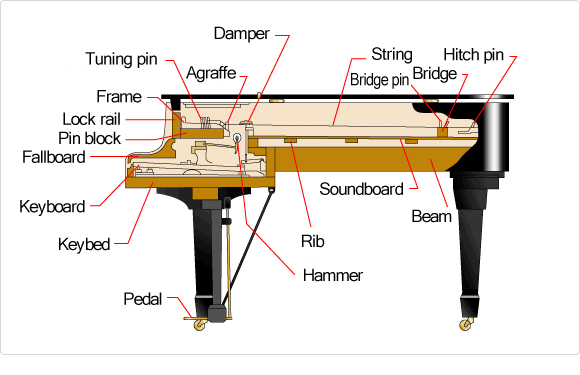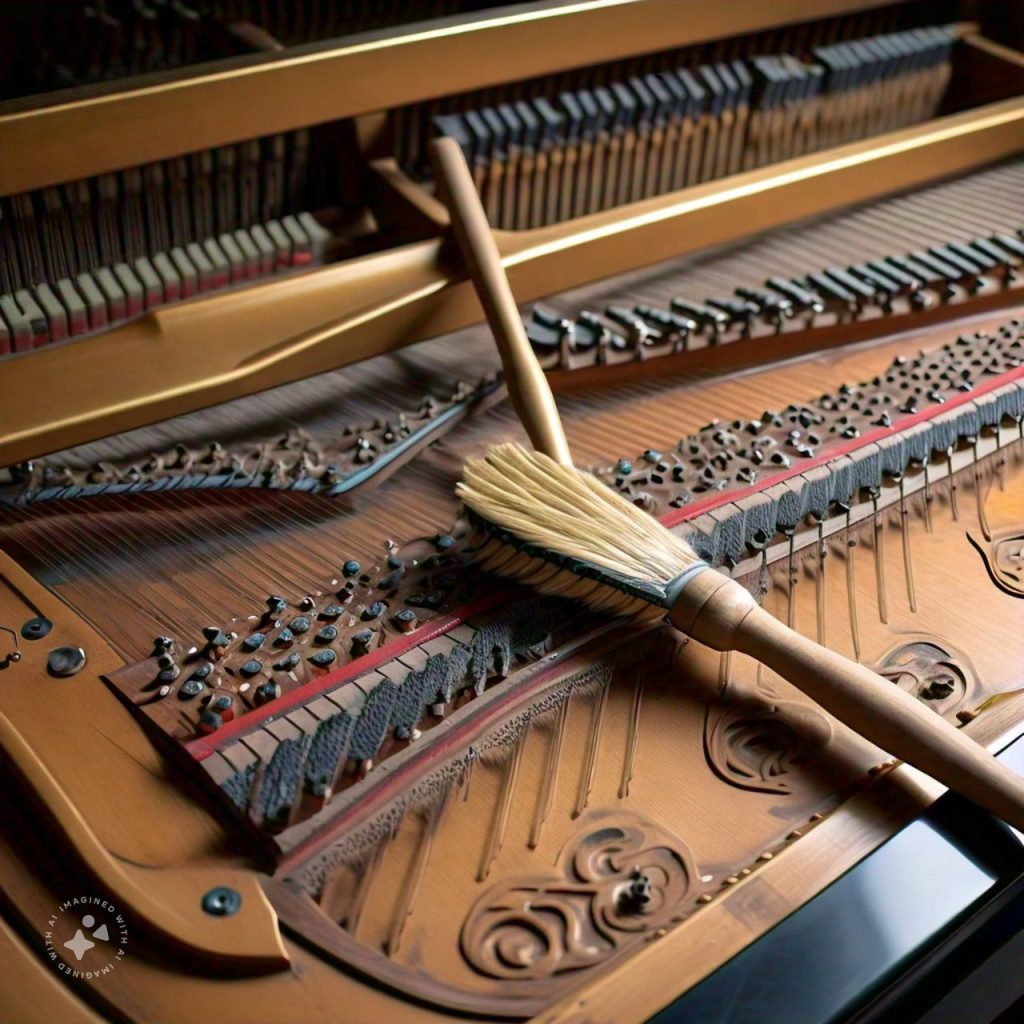A GUIDE TO PAINO PARTS
PAINO WIRES
A Guide to Piano Parts
The standard modern piano is a symphony of parts that come together in harmony. We offer the full range of piano parts of the highest quality.
Many piano enthusiasts want a thorough understanding of how their instrument works. This can help you understand your maintenance needs so you can understand basic maintenance and when to see a technician.
Read on for a quick rundown of what goes into a grand piano.
Structure: A piano anatomy overview

How piano keys work
••White piano keys, or “natural” keys enable you to play in C major. They represent the tones A, B, C, D, E, F, and G. Black piano keys fill in the rest.
For piano keys to run smoothly, they should be cleaned at least twice per week. If you do not use your piano regularly, less maintenance may be acceptable. Remember that while you may not see it, piano keys easily gather oil, sweat, and dust.
You should regularly clean your piano keys with a soft and dry cloth. Occasionally, you should conduct a deeper clean with a damp cloth and mild soap. Make sure none of the liquid gets between the keys!
Other tips for maintaining piano keys include:
- Keeping humidity levels below 50%
- Avoiding direct sunlight
- Regular tuning (we offer tuning pins)
- Professional tuning at least twice per year (with regular use)
- Replacing your piano keys if they are damaged or worn
Key pins guide and stabilise your piano key movements. Balance rail pins act as pivot points, while front rail pins keep the front of the key stable and guide the key’s movements.
Over time, key pins can deteriorate due to:
- Dust and debris
- Lack of lubrication
- Wear and tear (primarily bending)
- Humidity
We offer balance rail and front rail key pins, as well as the lubricants they need to remain in good working condition.
How many white keys are on a piano?
There are 52 white keys on a standard piano.
How many black keys are on a piano?
There are 36 black keys on a standard piano.
Piano hammers
A piano hammer is the part of the piano action mechanism that produces the music. The quality of your hammers is responsible for the sound quality it produces. It’s a simple mechanism:
- The piano key is pressed
- The action mechanism lifts the hammer
- The hammer hits the string, producing a sound
- The hammer rebounds to the resting position once released
Over time and with repeated use, piano hammers can become worn. As the hammer becomes compacted, it starts to affect the key’s tone. To ensure these piano parts produce the right note you must:
- Voice (harden) the shape of the hammer felt
- Align your hammers to strike evenly
- Reshape deformed hammer heads
- Replace broken heads
- Clean and adjust the hammer rail
We offer a full range of piano hammer head sets for upright and grand pianos. Our products can be put in any pianos from Abel or Imadegawa. See our catalogue for the full list of piano heads and relevant maintenance products.
What are piano hammers made of ?
Piano hammers are made from a wooden moulding covered in compressed felt. The felt must be maintained and replaced as needed to maintain strong, powerful notes.
Piano strings
Strings for pianos are remarkably similar to those of a string instrument. Vibrating strings are the result of a hammer striking the string. The string vibrations then travel through the bridges into the soundboard, producing music. The pitch then relies on the length, thickness, and tension of the string.
Piano stringing should be conducted with quality high-carbon steel to remain strong and durable. All our piano strings are strung with top-quality German steel and copper wire. We offer custom bass stringing (full or partial sets) and all the stringing accessories needed to maintain standard grand or upright pianos.
Bass strings
Piano bass strings enable bass notes. Unlike strings for tenor and treble notes, they are made of wound copper wire instead of bare, unbound wire.
Piano string maintenance
Piano strings need to be tuned at least twice per year with regular use. They require cleaning and inspection for wear and tear. This is because over time, with or without use, they may be subject to:
- Wear
- Discoloration
- Rust
- Dust & debris
- Corrosion (copper)
- Humidity
If left to deteriorate for too long, piano strings may produce buzzing, unnatural sounds. They may then deteriorate further, producing unpleasant sounds or breaking. In these cases, string replacement is required.
How piano soundboards work
Your piano soundboard is the sound-producing mechanism. It’s a complex instrument on its own requiring several materials and tailored maintenance tools. We offer the soundboard brushes, buttons, shimming tools, and steel needed for transmitting sounds into beautiful music.
Once the strings are struck as a key is pressed, the vibration moves through the bridge. Through there, the vibrations enter the soundboard. A loud sound comes out, with the vibrational character of the piano exiting into the open air. The entire piano vibrates with each pressed key, with the soundboard being the notable, sound-producing end of each vibration’s journey.
Soundboards are composed of multiple materials. Most of it is comprised of multiple layers of wood (spruce) stuck together. Spruce is a lightweight and flexible wood that enables the quick transmission of sound that you hear when pianos are played.
Soundboard maintenance

As with every part of the piano, soundboard components are vulnerable to damage caused by humidity, debris, and wear. That’s why regular maintenance checks and a good soundboard duster are so important. You should not just use any brush.
Be sure to sweep dust and debris off your soundboard during the recommended bi-annual cleaning sessions. Pay special attention to the pin blocks.
